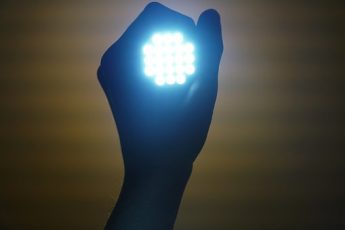Overview
Quick Navigation
Flashlights are different from one another in several ways. Manufacturers often make sure that they add unique features that would distinguish their products from other market models or types. However, there is a specific feature that these flashlights share in common – Lumens.
What are Lumens in a Flashlight? What are the things to consider before buying a flashlight? What are the best flashlight brands? These are some of the questions that buyers often ask before deciding to use a flashlight at all. Interestingly, not many answers have been convincing; nevertheless, you will find what you seek in this article.
Questions
Why are Flashlights Important?
Flashlights build confidence in the dark. They are a useful source of light for safety and protection. Even though they exist in various forms and construction, the goal remains the same: enhancing visibility.
LED Flashlights are the most popular types; they are useful for tactical and outdoor purposes, including hiking, running, camping, backpacking, etc. They are also suitable for self-defense, as they can temporarily blind an attacker while you run to safety. Ideally, LED Flashlights are better than Conventional Flashlights in every way.
The ability to do all of these things mentioned above is the quality and brightness settings in such a flashlight. The number of Lumens represents the brightness.
What are Lumens?
Lumens is described as the total output of a light source – flashlight, headlamp, bulbs, etc. Usually, Lumens vary from one light source to another – they are all rated with this measurement. Thus, you will discover that some headlamps are brighter than some flashlights and vice-versa. However, you must know that the higher the Lumens, the brighter and the more visibility – even though it could be dangerous sometimes.
What are the Types of Lumens?
Since Lumens is a factor that determines the brightness of light devices, you must know that they are divided into three categories.
- Short Lumens
Concentration Flashlights and Candlelights belong to this group of Lumens because they are extremely small. They range between 1 to 30 Lumens. Flashlights that have these Lumens are only suitable for focusing and night reading.
- Average Lumens
The ideal flashlight for outdoor purposes has an average lumen. It often ranges between 100 to 500 Lumens for visibility and safety. Many brands have their flashlights configured into this category for wide distance illumination. It is also a description distance, i.e., how many feet the flashlight would cover –100 Lumens for 100 ft. or 500 Lumens for 500 ft.
- High Lumens
The last type of Lumens is the High Lumens. It is mostly designed for specific headlamps and street lamps to provide superior brightness and a different visibility level. They are always 1000 Lumens or higher. Most law enforcement and security companies use them.
See here for the best flashlight brands on the market.
Overall, you would agree that a good flashlight should have an average lumen; if anything comes greater than that, it could be dangerous.
What Other Factors to Consider Before Choosing a Flashlight?
Apart from the Lumens, you need to check other factors/features before buying a flashlight. Here is a description of some of those factors.
- Bulb
Every flashlight has a bulb that delivers the light emitted by a flashlight. However, the bulb quality differs from one flashlight to another. LED Bulbs, however, is the best compared to the other type – Incandescent Bulbs. Most tactical flashlights use LED Bulbs because it has better energy efficiency, impact resistance, and brightness potential than other types. Therefore, it is a significant factor to consider.
- Construction
Flashlights are designed with special types of materials, mostly Alloy and Aluminum. The tough body construction makes them able to resist impact; thus, they guarantee excellent durability. Likewise, most flashlight constructions don’t go without waterproofing potentials.
Additionally, the shape is another factor in a flashlight’s body construction. As you know, most flashlights are designed in a cylindrical shape, making them liable to roll; however, an anti-roll technology has been incorporated for stability. Furthermore, the knurled pattern on the surface makes them anti-slip.
- Modes and Controls
Another fantastic set of factors that makes the difference between flashlights are the Modes and Controls. Some flashlights’ beautiful design isn’t all to sell; the way they are controlled and adjusted for brightness or visibility is also important. In Modes, top-rated flashlights have 2 or more types that mostly include – High, Low, Medium, SOS, and Strobe Settings. They are programmed into the flashlight for a superior beam and illumination.
Controls, on the other hand, determine the ease of switching the flashlight on or off. Most flashlights use either thumb-influenced push buttons or sliders. Sometimes, they have a safety lock mechanism to ensure that buttons aren’t pushed unnecessarily.
- Beam Type
With the presence of bulbs, different beam types could be experienced. Beams, generally, are used in describing the direction of light when a flashlight is turned on. These beam types include;
- Fixed Beam
- Focused Beam
- Adjustable Beam
- Battery
: Delivers a single beam and is ideal for walking or reading.
: Delivers separating beams over a distance.
: It transcends from fixed to focused beam due to the presence of an adjustment knob.
The functionality of a flashlight wholly depends on the type of battery it uses. Generally, batteries produce electric currents that are utilized by the flashlight to provide light for visibility. However, you need to carefully choose what is appropriate for the occasion since there are different flashlights based on battery types.
- Rechargeable Flashlights use batteries that are constantly recharged by electricity to provide light.
- Non-Rechargeable Flashlights only use disposable batteries, such as AA batteries, to stay powered. The interesting thing about these flashlights is that their batteries can always be replaced when they die.
Conclusion
“What are Lumens in a flashlight?” and a few other questions is enough information to show you why flashlights are essential in day-to-day life. Even though they seem unnecessary, their importance in safety and protection cannot be overemphasized. In conclusion, choosing a flashlight based on its Lumens is an ideal way to start looking out for your safety.

